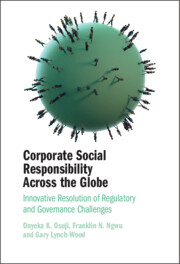 Corporate Social Responsibility Across the Globe
Corporate Social Responsibility Across the Globe from Part II - Infusing Corporate Social Responsibility in Corporate Governance
Published online by Cambridge University Press: 15 June 2023
Increasing regulatory oversight to control shareholders is bound to underperform. This is because it rests on an invalid assumption, namely that shareholders are better controlled and better steered when regulatory stringency is increased. The assumption runs counter to the conditions that a regulation must require of shareholders, owing to those conditional requirements being unevenly matched by shareholders. Specifically, since shareholders vary in what is required of them by a regulation, the increase of regulatory oversight necessitates that some shareholders will fail to respond, some will comply with what is required, and others will do more. Increasing regulatory oversight does not therefore address the fundamental problem of there being pre-existing deficiencies in stakeholder capacities to comply. To better address the problem, a minmax approach to regulation is proposed. The main benefit of minmax is that it aligns itself to shareholder differences, helping to reduce non-compliance while simultaneously encouraging beyond-compliance behaviour.
To save this book to your Kindle, first ensure no-reply@cambridge.org is added to your Approved Personal Document E-mail List under your Personal Document Settings on the Manage Your Content and Devices page of your Amazon account. Then enter the ‘name’ part of your Kindle email address below. Find out more about saving to your Kindle.
Note you can select to save to either the @free.kindle.com or @kindle.com variations. ‘@free.kindle.com’ emails are free but can only be saved to your device when it is connected to wi-fi. ‘@kindle.com’ emails can be delivered even when you are not connected to wi-fi, but note that service fees apply.
Find out more about the Kindle Personal Document Service.
To save content items to your account, please confirm that you agree to abide by our usage policies. If this is the first time you use this feature, you will be asked to authorise Cambridge Core to connect with your account. Find out more about saving content to Dropbox.
To save content items to your account, please confirm that you agree to abide by our usage policies. If this is the first time you use this feature, you will be asked to authorise Cambridge Core to connect with your account. Find out more about saving content to Google Drive.